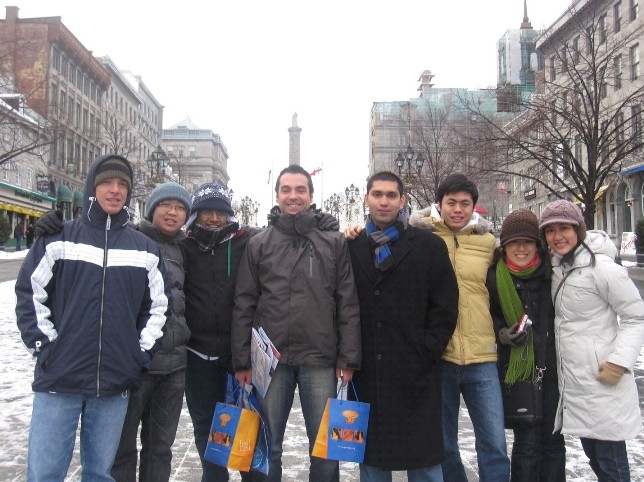Written by The NANYANG MBA 2011 Team to John Molson
Alexander Pflock (Full time / Germany),Joseph Arollado (Full time / Philippines)
Irfan Khan (Full time / USA)
Manu Muraleedharan (Full time Double Degree Waseda / India)
Marcus Yan (Full time Double Degree Waseda / Singapore)
For the 3rd straight year, Nanyang is sending a team for the 30th John Molson Case Competition in Canada, held from 3 to 8 Jan 2011. Our team is representing the Nanyang Business School, after beating a few teams at Nanyang. he selection process for the NBS team was an in-class case competition among aspiring teams, during the New Venture Practicum course. We were really excited when we heard about our being chosen as the team and were proud to represent NTU at the competition.
On the first day, the committee organized a city chase in the morning to familiarize the participants with the city and the neighborhood. After going through administrative procedures in the afternoon, we had the opportunity to meet the other 35 competing schools at the cocktail lounge.
Our Team, comprised of Irfan , Alex , Marcus ,Manu and Joseph newly arrived at the competition center.
On the second day, all the participants had their game faces on as they eagerly waited for the actual competition to start. The schedule and mechanics of the competition were straight forward. The entire competition lasts for a total of five days. Three and a half days were allocated for elimination, half a day for semi-finals and the last day for the finals. 36 competing teams were segregated into 6 divisions. The elimination round was a head-to-head, round-robin system where we would have to compete against the other 5 teams in our division. The scoring system was a bit complicated. Judges would have to split a total of 11 points between the competitors. The gap between the winner and loser can be as wide as 11 – 0, or as close as 6 – 5. The actual mechanic for the case analysis and presentation was again pretty simple. Groups were brought in to isolated rooms wherein they were given three hours to analyze a case. After three hours, teams would have to proceed to the presentation room where they were given 25 minutes to present, and 15 minutes to answer questions from the judges. The exceptions were the “live” case in which a team is given only 2 hours to prepare and a “short” case wherein a team had only 15 minutes to present. The analysis was all written down in transparencies and presented using an over-head projector.
Our Team, sitting relaxed in the presentation board room, while waiting for the competition.
The competition was very tough as most of the schools came in well prepared. Just like our school, many schools had a special course designed specifically to prepare students for this competition. Though the strategies or analysis were quite similar across the teams, the presentation styles were clearly different. Some teams were really polished, in the sense that they already had a certain routine prepared. They were even trained on using the transparencies which was evident with creation of on the fly templates on transparency.
Given the amount of lead time between selection and the competition and the number of relevant courses our team members have done, we performed really well. We believe that some aspects of the competition, specifically presentation, can be learned and further improved. On the other hand, we felt really proud of ourselves, knowing that our ideas and creativity gave us an edge over our competitors. In fact, we were able to beat Queen’s School of Business who were the runner-up at the end. All-in-all, the competition gave our team valuable insights about our strengths, weaknesses and team dynamics. One lesson we learned is that our team excelled in thinking out of the box. Furthermore, our team members complimented each other in terms of knowledge and contributions. On the other hand, we realized that presenting collectively is a skill that we had taken for granted. In addition, we understood the importance of composure in such competitions.
On the lighter side, the organizing committee made sure all the 36 schools got enough time to interact with each other. To achieve this, they organized a networking event every evening – cocktail night, ball dance, hockey night. They even had a learning session for ball dance. We also attended informal networking sessions every night at the hotel, where we discussed the proceedings of the day and also discussed on the strategy changes the next day. The best part about this competition was that not only we got to meet peers from schools all around the world, but also the coaches of those schools were open to sharing where they thought our team was going wrong and what should we focus on. So, the competitors during the day time became your friends and teachers in the evening.
Our team, spending some light moments, trying out the cold outdoors, with some of the competing students,



